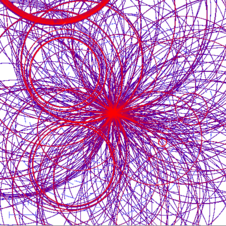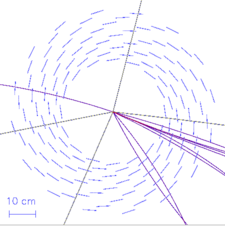In the field of High Energy Physics (HEP) there many different algorithms used for

reconstruction of physics particles in the detector. When certain particle traverses the
detector, the underlying electronics capture its trajectory. Those signals latter
are transformed into
hits, the space points which are used by underlying
algorithms to reconstruct the particle trajectories. On the left side you may see
a typical event produced in HEP experiment where red trajectories represent
different particles. Now imaging a thousands of hits in space which you need
to analyse to produce this picture. The underlying algorithm should be fast,
reliable and robust to the noise and fakes. Such task is called
tracking algorithms in HEP field. I've been participated in their
design and implementation in three HEP experiments
(NOMAD, NOMAD-STAR and DZero).
Almost all tracking algorithms used in HEP are based on Kalman filter.
The Kalman filter is the optimal estimator of the state vector of a
linear dynamical system, since it minimizes the mean square estimation error.
The Kalman filter proceeds by performing these three distinct operations:
- Prediction, where the status of the state vector is estimated
at a future measurement point;
- Filtering, where the current estimation of the state vector
is carried out based on the previous measurements; and
- Smoothing, where the estimation of the state vector at a
previous measurement is re-evaluated with the new information
of the present measurement.
A full description of Kalman algorithms can be found
here.
 Once all particle are identified by tracking algorithm the next challenging
task to identify the nature of the reconstructed particle. For example,
on left side
you may see the same event where 4 muons were identified by particle
identification algorithm which use available information in different
detector sub-system, analyse and predict with certain efficiency
the underlying particle type.
Once all particle are identified by tracking algorithm the next challenging
task to identify the nature of the reconstructed particle. For example,
on left side
you may see the same event where 4 muons were identified by particle
identification algorithm which use available information in different
detector sub-system, analyse and predict with certain efficiency
the underlying particle type.